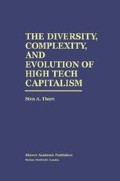Abstract
To economists, the word production means the generation of goods and services that have a value in the marketplace. Thus, production is not just the manufacture of an automobile or a synthetic drug, it is also computer consulting and open heart surgery.
Access this chapter
Tax calculation will be finalised at checkout
Purchases are for personal use only
Preview
Unable to display preview. Download preview PDF.
References
“Imagine that we could enter today the first exhibition…” J.B. Priestley, Victoria’s Heyday, William Heinemann, London 1972.
“The passenger train was one of the glorious products …” I have used N.L. Wayman, St. Louis Union Station and Its Railroads, The Evelyn E. Newman Group, St. Louis, Missouri 1987.
“This is the so-called ‘learning curve’” L. Argote and D. Epple, “Learning Curves in Manufacturing,” Science, 23 February 1990, pp. 920–924.
“An early master — and an evil master —” W. Manchester, The Arms of Krupp, Little, Brown and Co., Boston 1964.
“The agony of bringing on line…” C. Prestowitz Jr., Trading Places: How We Allowed Japan to Take the Lead, Basic Books Inc., New York 1988, and J.George, “High-Technology Competition between U.S. and Japanese Companies,” in Japan Business Study Program, 1989, ed. by H. Matsuo, Bureau of Business Research, The University of Texas at Austin.
“As a convenient point of departure…” R.M. Solow, “Technical Change and the Aggregate Production Function,” Review of Economics and Statistics, August 1957,pp. 312–320.
“In a series of publications, E.F. Denison tried to…” E.F. Denison, The Sources of Economic Growth in the United States and the Alternatives Before Us, The Committee for Economic Development, New York 1962, Why Growth RatesDiffer, The Brookings Institution, Washington D.C. 1967, Accounting for United States Economic Growth 1929-1969, The Brookings Institution, Washington D.C.1974, Trends in American Economic Growth, 1919–1982, The Brookings Institution, Washington D.C. See also E.F. Denison and W.K. Chung, How Japan’s Economy Grew so Fast, The Brookings Institution, Washington D.C. 1976. For other key works on productivity, consult J.W. Kendrick, editor, International Comparisons of Productivity and Causes of the Slowdown, American Enterprise Institute, Ballinger Publishing Co., Cambridge, Mass. 1984 and Angus Maddison, “Growth and Slowdown in Advanced Capitalist Economies: Techniques of Quantitative Assessment,” Journal of Economic Literature, June 1987, pp. 649-698.
“The existence of a residual…” R. Stone, “Whittling Away at the Residual: Some Thoughts on Denison’s Growth Accounting,” Journal of Economic Literature, Dec. 1980, pp. 1539–1543.
“How does new technology raise productivity?” For an instructive statistical investigation, see K.-O. Faxén, CE. Odhner, and R. Spånt, Lönebildningen i 90-talets Samhällsekonomi (Wage Formation in the Economy of the 1990s), Raben & Sjögren, Stockholm 1988, pp. 173–176.
“Application of these ideas leads to…” S. Thore, “A Constrained Least Squares Method for Estimating the Effects of an Unknown Monotonically Intervening Factor,” Journal of Forecasting, Vol. 8, 1989, pp. 369–379 and S. Thore, G. Xia and T. Song, “Irreversible Technological Progress and Innovations: Endogeneous Estimation of Discrete Shift Variables,” presented at the Georgia Productivity Workshop, The University of Georgia, Athens, October 1994, submitted to Journal of Productivity Analysis.
“The technique is called data envelopment analysis…” A. Chames, W.W. Cooper and E Rhodes,“Measuring Efficiency of Decision Making Units,” European Journal of Operational Research, Vol. 3,1979, pp. 429–444. Also, by the same authors, “Data Envelopment Analysis as an Approach forEvaluating Program and Managerial Efficiency — with an Illustrative Application to the Program Follow Through Experiment in U.S. Public School Education,” Management Science, Vol. 27,1981, pp. 668-697.
“… with the successful site selection of the super-collider to Waxahachie, Texas” R.G. Thompson, F.D. Singleton, Jr., R.M. Thrall, and B.A. Smith, “Comparative Site Evaluations for Locating a High-Energy Physics Lab in Texas,” Interfaces, Vol. 16, 1986, pp. 35–49.
“To illustrate, we may take a quick look at …” The DEA calculations mentioned in the text are reported in S. Thore, “Cost Effectiveness and Competitiveness in the Computer Industry: A New Metric,” Technology Knowledge Activities, Vol.1, No.2, Fall 1993, pp. 1–10. See also S. Thore, G. Kozmetsky, and F. Phillips, “DEA of Financial Statements Data: The U.S. Computer Industry,” Journal of Productivity Analysis, in press 1994.
“The purpose of the Santa Fe Institute, says founder George Cowan…” Cited after M.M. Waldrop, Complexity: The Emerging Science at the Edge of Order and Chaos, Simon & Schuster, New York 1992, p. 68.
“Santa Fe economist B. Arthur…” W.B. Arthur, “Competing Technologies, Increasing Returns, and Lock-In by Historical Events,” The Economic Journal, March 1989 and “Positive Feedbacks in the Economy,” Scientific American, February 1990, pp. 92-99.
Author information
Authors and Affiliations
Rights and permissions
Copyright information
© 1995 Springer Science+Business Media New York
About this chapter
Cite this chapter
Thore, S. (1995). The Technology Frontier. In: The Diversity, Complexity, and Evolution of High Tech Capitalism. Springer, Dordrecht. https://doi.org/10.1007/978-94-011-0659-7_4
Download citation
DOI: https://doi.org/10.1007/978-94-011-0659-7_4
Publisher Name: Springer, Dordrecht
Print ISBN: 978-94-010-4288-8
Online ISBN: 978-94-011-0659-7
eBook Packages: Springer Book Archive

